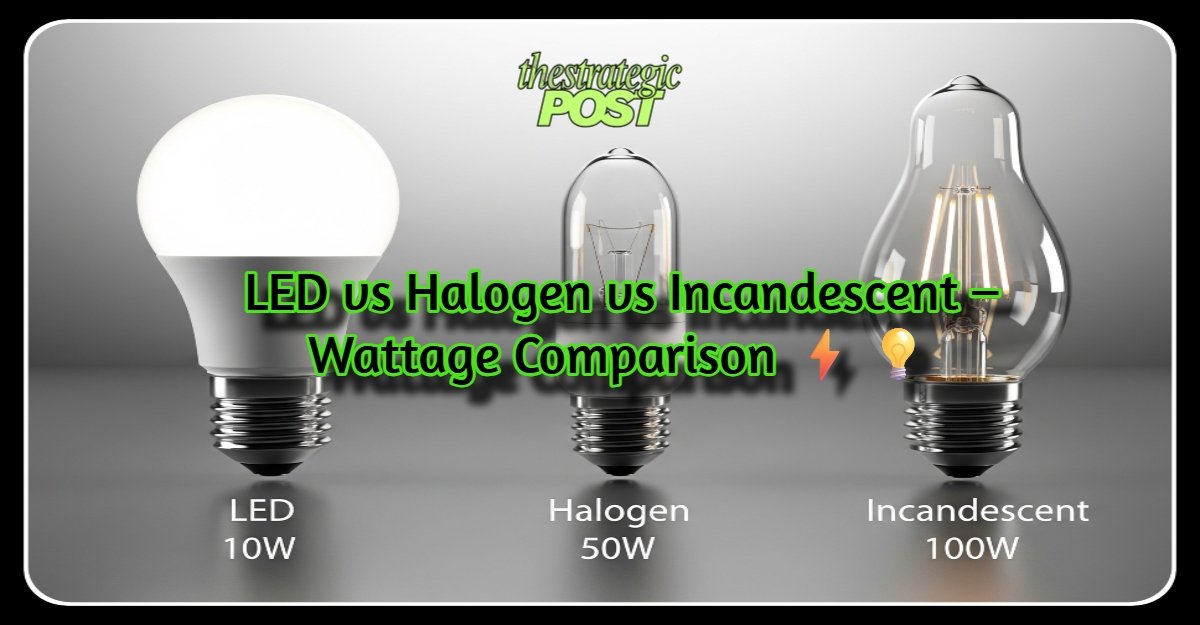Table of Contents
LED vs Halogen vs Incandescent — Wattage Comparison ⚡💡
Published: September 3, 2025
LED vs Halogen vs Incandescent — Wattage Comparison ⚡💡 : Want the brightness of a 100-watt old-school bulb without roasting your electricity bill? Here’s your quick, no-fluff guide to what wattage you actually need when switching between LED, Halogen, and Incandescent. Bookmark this—your future self (and meter) will thank you.
TL;DR (Pick Your Bulb Fast)
- Match brightness by “lumens,” not watts. Watts = power used; Lumens = light output.
- LEDs deliver the same brightness at ~75–85% less power than incandescent and ~60–70% less than halogen.
- Use the chart below to grab the right LED for a fixture you’re used to running with older bulbs.
Quick Equivalence Chart (Brightness Match)
| Incandescent (classic) | Halogen (newer old-tech) | LED (efficient) | Typical Use Case |
|---|---|---|---|
| 25W | ~18W | 2–4W | Nightstands, accent lamps |
| 40W | ~28W | 5–7W | Bedrooms, hallways |
| 60W | ~42W | 8–10W | Living rooms, kitchens |
| 75W | ~53W | 9–13W | Task lighting, larger rooms |
| 100W | ~70W | 13–18W | Garages, high-ceiling spaces |
These ranges reflect typical market bulbs. Actual brightness depends on the lumens listed on the box (see next section).
The Rule That Saves You Money: Buy Lumens, Not Watts
When shopping, find the Lighting Facts label and look for Lumens:
- ~300 lm ≈ old 25W bulb
- ~450 lm ≈ old 40W
- ~800 lm ≈ old 60W
- ~1100 lm ≈ old 75W
- ~1600 lm ≈ old 100W
Now choose the lowest-watt LED that hits those lumens. That’s the whole game.
Color & Quality: Make Your Room Look Right
- Color Temperature (K):
- 2700–3000K = warm/relaxing (bedrooms, living rooms)
- 3500–4000K = neutral/clean (kitchens, bathrooms)
- 5000K+ = daylight/alert (garages, craft tables)
- CRI (Color Rendering Index):
- CRI ≥ 80 is fine; CRI 90+ makes colors pop (great for makeup tables, art, photos).
LED vs Halogen vs Incandescent: What Changes in Real Life?
LED
- Uses the least power, runs cool, lasts years (often 15,000–25,000 hours).
- Available in dimmable, smart, and high-CRI versions.
- Upfront cost higher, but total cost is lowest over time.
Halogen
- Slightly more efficient than incandescent; instant full brightness, naturally warm.
- Great dimming feel, but shorter life and hotter operation.
- Often phased out in many regions due to efficiency rules.
Incandescent
- That nostalgic glow—but it’s basically a tiny heater that happens to make light.
- Highest energy use, shortest life. Keep for specialty fixtures only.
How to Switch Without Headaches (3-Step Method)
- Decide brightness by lumens (use the table above).
- Pick mood by color temperature (2700–3000K cozy, 4000K clean, 5000K daylight).
- Check extras: dimmable? smart? CRI ≥90? enclosed-fixture rated if the globe is sealed?
Mini Cheat Sheets
For a 60W vibe:
- Choose ~800 lumens → typically 8–10W LED (or 42W halogen if you must).
For a 100W vibe:
- Choose ~1600 lumens → typically 13–18W LED (or 70W halogen).
For reading lamps:
- Aim 800–1100 lm, 3000–4000K, CRI 90+ if you’re picky about print and color.
FAQs
Q: My LED says “60W equivalent” but feels dim. Why?
A: Ignore the marketing—check lumens. You want ~800 lm for a true 60W feel.
Q: Do LEDs work with my old dimmer?
A: Many do, but you need “dimmable” LEDs and a LED-compatible dimmer to avoid flicker.
Q: Can I use LEDs in enclosed fixtures?
A: Only if the package says “enclosed-rated.” Heat kills LED lifespan.
Q: Are warm LEDs as cozy as incandescent?
A: Yes—look for 2700K and, if possible, dim-to-warm models that get warmer as you dim.
Bottom Line
If you’re upgrading from older bulbs, grab the lumens target that matches your old wattage, then pick the lowest-watt LED that hits it. You’ll keep the brightness you love while slashing energy use—no guesswork, no glow-downs.
Want more quick, practical guides like this? Bookmark TheStrategicPost—we turn techy choices into 2-minute wins.

